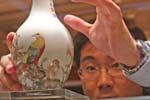Heritage
Liang home 'never under threat'
Updated: 2011-04-11 08:03
By Qin Zhongwei (China Daily)
Suggestions that the Xinhui Assembly Hall - No 115 in Liuli Lu - was to be among 30 Qing Dynasty (1644-1911) clan association homes razed by the bulldozers sparked much debate among netizens.
|
The entrance of what was once thinker Liang Qichao's home, as it looked on Sunday. The building is to be renovated. Qin Zhongwei / China Daily |
However, in a statement issued by the district's publicity office, officials assured that the building is on the protection list and will be renovated after residents in the surrounding hutong are relocated.
The April 7 notice also corrected a Beijing Times report that said the house was Liang's permanent residence. Instead, officials say the famed politician and thinker only lived there temporarily during his marriage and for visits to the capital in the 1890s. His formal residence is in Dongcheng district and was listed as a district-level protected relic in 2006, the statement added.
During a visit to Xinhui Assembly Hall last Saturday, METRO reporters passed rows of courtyards with signs outside that say "demolition". The sign on the exterior wall of 115 has been scrubbed out.
A man in his 50s who did not want to be identified said his family is one of about 20 households still living nearby. He did not know when his home will be razed.
Cao Zhen and Liu Yuanyuan, two students who had read about the house in the newspapers, were taking photographs of the hutong.
"We just feel it's a pity if all these yards are gone, along with the memories," said Cao.
Official statistics show there were once 101 clan association halls in Xicheng, with 94 of them occupied since the 1960s.
The buildings were mostly built by young people who came from other provinces for the imperial examinations in late Qing era. They were later used to house the homeless after the founding of New China in 1949.
Luo Zhewen, a scholar of ancient architecture, called for a detailed survey on the 30 houses to ensure the best level of protection.
Although the government feels the doomed buildings offer very little historic value, families say they represent the traditional Beijing community.
"We've been seeing each other for decades," said a resident surnamed Liu when asked about the relocation plans. "We won't be as close living in apartment buildings."
E-paper

Green light
F1 sponsors expect lucrative returns from Shanghai pit stop
Buying into the romance
Born to fly
Light of hope
Specials

Share your China stories!
Foreign readers are invited to share your China stories.

No more Mr. Bad Guy
Italian actor plans to smash ‘foreign devil’ myth and become the first white kungfu star made in China.

Art auctions
China accounted for 33% of global fine art sales.

